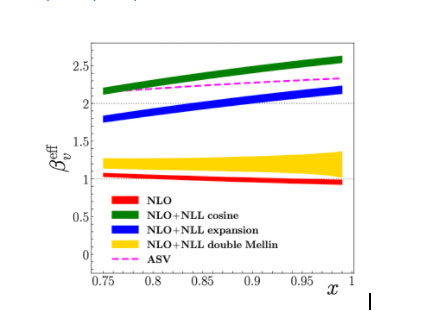
Effective exponent on the large $x$ behavior of the valence quark distribution for various threshold resummation calculations used in the extraction. The distributions follow $(1-x)^{\beta^{\rm eff}_v}$.
Global QCD analysis of pion parton distributions with threshold resummation
P.C. Barry1, Chueng-Ryong Ji2, N, Sato1, and W. Melintchouk1
1 Jefferson Lab, Newport News, Virginia 23606, USA
2 Department of Physics, North Carolina State University, Raleigh, North Carolina 27695, USA
Jefferson Lab Angular Moment (JAM) Collaboration
In 2018, the JAM collaboration performed the first Monte Carlo global QCD analysis on pion parton distribution functions (see here: https://journals.aps.org/prl/abstract/10.1103/PhysRevLett.121.152001) by including data from Drell-Yan experiments and for the first time, the leading neutron electroproduction from HERA. The large-$x$ behavior of the pion’s valence quark distribution from using next-to-leading order in the strong coupling analysis followed $(1-x)$, but there has been debate whether it should be $(1-x)^2$. In this analysis, we have systematically included various calculations of the threshold resummation at next-to-leading logarithmic accuracy for the Drell-Yan partonic cross section and performed a simultaneous fit of the pion PDFs to the Drell-Yan and leading neutron data. We do not find a universal behavior of the large-$x$ valence quark distribution, and it depends significantly on the method of threshold resummation. The effective exponent of $(1-x)^{\beta^{\rm eff}_v}$ is shown in the figure above, where $\beta^{\rm eff}_v$ ranges from $\approx 1-2.6$. The most theoretically trustworthy approach is the double Mellin, which includes all terms of order of the expansion.

